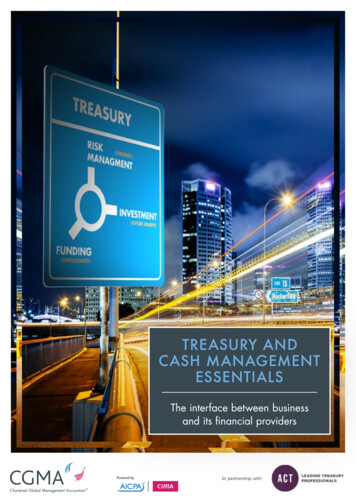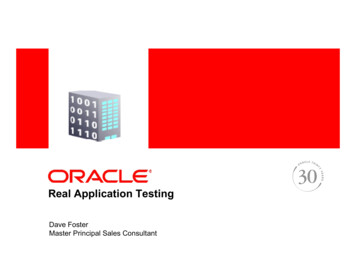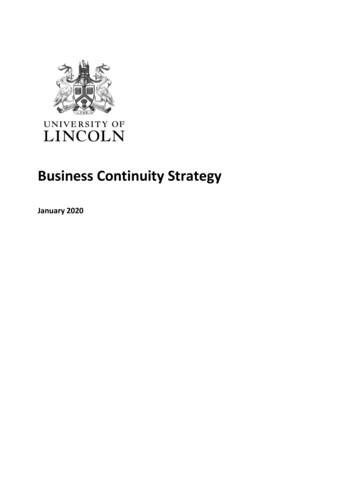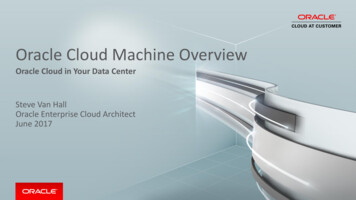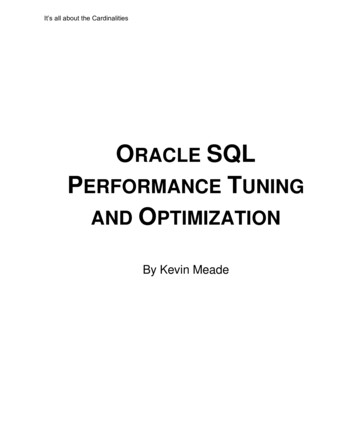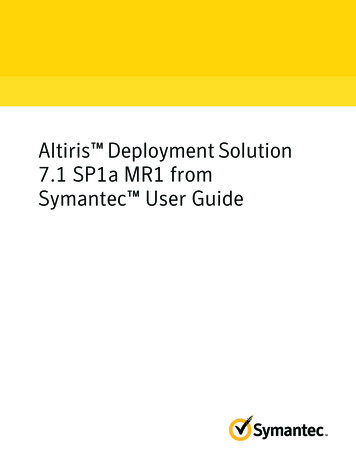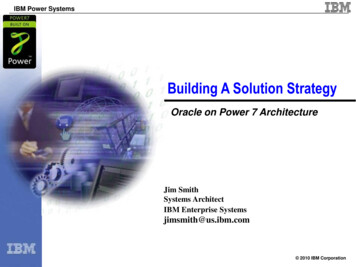
Transcription
IBM Power SystemsBuilding A Solution StrategyOracle on Power 7 ArchitectureJim SmithSystems ArchitectIBM Enterprise Systemsjimsmith@us.ibm.com 2010 IBM Corporation
IBM Power SystemsIBM – only systems provider with complete storyIBMHPOracle / dRISC/UNIX marketleaderArchitecture fallingfurther behind – futuredoubtfulLosing market share –customers migratingx86x86x86Platinum standard forreliability, availabilityand securityMarket leader in 4way enterpriseworkload serversStrong competitor –overall market leader“Want a be” – sellinginto existing installbase primarilyNo offeringsx86Strong GB competitor– still not a top of mindin most enterprises IBM Advantages: Uniqueability to offer architecture/platform that best fits enterprise customer requirements/environments Alreadydelivering workload optimized solutions Onlyprovider offering the highest qualities of service available with choice of System z mainframe, Power, or System x Abilityto leverage „breadth‟ of IBM – Services, Financing, Storage, Software 2010 IBM Corporation
IBM Power SystemsScaleTime HorizonISV stem EnvironmentalConstraintsPowerArchitectureLocal Factors Matter Skills Technology adoption Management Volume of servers Organizational Balancing Strategicand TacticalRequirementsPlatform capabilityFit for purpose Highlights: Local Factors Local FactorsStrategic DirectionPoliticsPlatform ASkillsTCO ModelPlatform BLocal factors affect platform selectionInfrastructure Size Matters Changes people dynamics Increases handoffs Affects testing, patching, etcApollo 13 Transaction Processingand Database Analytics and High Performance BusinessApplications Web, Collaboration and Infrastructure TCA TCOCost & Chargeback models may distort theselection processWorkload Matters 2010 IBM Corporation
IBM Power SystemsOracle Solution Costs2009EnvironmentHardwareCost Trends /- 10% /- 20%30 - 60%Software25 - 50%PeopleIDC Estimates - 2009The justification in spending on better technology is in theeffect on software, personnel and environmental expense.AND you get better technology 2010 IBM Corporation
Coopertion is alive and well 2007
Coopertion is alive and wellIBM-Oracle International Competency CenterMission:Provide technical pre-sales solution support for Oracleapplications and technology with IBM platforms including:PeopleSoft, JD Edwards, Siebel, EBS, and others. On-Site Resources IBM Hardware andSoftware Brand Experts Technology Managers Solutions Sales Project Managers Labs Located at Oracle and IBM Benchmarking/Sizing tests Redbooks andwhitepapers Sizing Tools Creation and ownership ofworldwide sizing tools andprocesses Support the Techlineresources Technical Sales Support IBM Technical Sales Business Partners On-site briefings Third level support whennecessary 2007
IBM Power SystemsCustomers are moving to higher value as shown by the largest shift of customer spending in UNIX History40%World Wide UNIX Server Rolling Four Quarter Average Revenue 05Q104Q304Q103Q303Q102Q302Q101Q301Q1008In 2009 IBM Unix revenue share exceeded 40% world wide3) 70% of the database instances running on Power are OracleQ300Q10Q39915%9HPSunIBM1) IBMhas been#1 serverUnix vendorworld-widesince50%2004share(IDC) in NA.In 2009IBMtheUnixrevenueexceeded2) IBM’s growth is from competitive conversions / migrationSource: IDC Quarterly Server Tracker Q409 release, February 2010 2010 IBM Corporation
IBM Power SystemsPower Systems Portfolio Power 595Power 780ConsistencyBinary compatibilityMainframe-inspired reliabilityAdvanced VirtualizationAIX, Linux and IBM i OSComplete flexibility for workloaddeploymentPower 770Power 570Power 750Power 550Power 700701 & 702JS BladesPower 520Power 755Power 575HPC 2010 IBM Corporation
IBM Power SystemsBuilt for Oracle Performance LeadershipCores: POWER6Up to 8 Intelligent Cores / chip (socket)4 and 6 IntelligentCores available onsome modelsAltiAltiCoreCore12 executionVecunits per coreVecOut of order execution4 Way SMT per core32 threads per chipL1 – 32 KB I Cache / 32 KB D Cache per core4 MBL3 4 MBL3L2 –L3256 CtrlKB per L2coreL2Ctrl L3Chip: 32MB Intelligent L3 Cache on chipPOWER7POWERCoreCoreCoreCoreL2L2L2L2GXL3 CacheeDRAMMemory: MemoryCntrlScalability:MemoryCntrl Dual DDR3 ControllersFabric Bus 100 GB/s sustained Memory bandwidth / chipControllerUp to 32 Sockets360 GB/s peak SMPGXbandwidthBus Cntrl/ chip590 GB/s peak I/O bandwidth / chipUp to 20,000 coherent operations in emory InterfaceGX Aggressive processor BridgeNap & Sleep modes 10% “Overclock” when thermals aregoodMemory Memory Memory 2010 IBM Corporation
Power Systems Partitioning - Value to OracleDynamically Resizable1CoresLinux2CoresLinux24 52CoresCoresCores128GBAIXMemoryAIXV5.3 V6.1AIX, Linux, i3Cores3CoresLinuxAIXV5.3POWER Hypervisor8CoresCUoD
Power Systems Virtualization - Value to OracleDynamically Resizable1 nagerLinux52Cores Cores336CoresCoresCoresLinuxVirtual I/O pathsPOWER HypervisorIBM iOracle10gAIX V5.3Oracle11gAIX V6.111gOracleAIXV6.19iOracleAIX V5.3AIXV5.3Oracle9iAIX resAIXV5.3CUoDMicro-Partitioning Feature Share processorsacross multiplepartitions Minimum partition1/10th core 254 partition maximum AIX V5.3/6.1, Linux, &IBM iVirtual I/O server Shared Ethernet Shared SCSI & FibreChannel attached disksubsystems
Power Systems for Oracle– DB Consolidation, Virtualization –Dynamically acle10gOracle11gOracle 11gOracle 10gR2Oracle acle 11gIntVirtLinuxManager33 24CoresCoresCoresOracle9iOracle 10gOracle 10g1 Core1CoresI/OVirtualAIXV5.3CUoD1 agerStorageSharingEthernetSharingPOWER HypervisorISV Pricing on Power 48 core systemNetworkOracle EE: 38 coresDo not pay for VIO server or CUoD coresNetwork
Power Systems Virtualization - Value to OracleDynamically Resizable1Cores2Cores52Cores Cores336CoresCoresCores8Cores11g WASLinuxVirtual LANPOWER HypervisorIBM iOracle10gAIX V5.3Oracle11gAIX V6.111gOracleCognosWASV5.3AIXLinuxOracle9iAIX PowerVM’sAIXV5.3CUoDMicro-Partitioning Feature Share processorsacross multiplepartitions Minimum partition1/10th core 254 partition maximum AIX V5.3/6.1, Linux, &IBM iVirtual I/O server Shared Ethernet Shared SCSI & FibreChannel attached disksubsystems
Power Systems Virtualization for Oracle– Tier Consolidation & Virtualization –Dynamically Resizable6Cores33 24CoresCoresCores8CoresTier ConsolidationLinuxOracle10gOracle11gOracle 11gAIXV5.3Oracle 9iLinuxOracle9iOracle 10gOracle 10gPowerVM’sOracle 10gStorageSharingEthernetSharing8CoresOracle 1 Core1CoresI/OVirtualAIXV5.3CUoD1 agerStorageSharingEthernetSharingVirtual LANPOWER HypervisorISV Pricing on Power 64 core systemNetworkOracle EE: 38 coresWebSphere: 1920 PVUsDo not pay for VIO server or CUoD coresVirtual Network WebSphere to Oracle works at memory speedsNetwork
IBM Power Systems and Storage Competitive EducationCustomer Oracle DB Shared Pool15 2010 IBM Corporation
IBM Power Systems and Storage Competitive EducationConsolidating Workloads Optimizes Efficiency Single workload model As copies are added– Average: 21%; Peak: 79%– Random arrival rateSingle Application Server (2CPUs)– Average approaches peak– Total CPU grows at slower rate64 to 1 Consolidation (36 CPUs)8 to 1 Consolidation (8 20%10%10%10%0%0%0%80%70%60%50%40%Average 21%, Peak 79%Average 39%, Peak 76%Average 61%, Peak 78%16 2010 IBM Corporation
IBM Power SystemsActive Memory Expansion & Active Memory SharingValue To OracleActive Memory SharingMoves memory from one partitionto anotherBest fit when one partition is notbusy when another partition isbusyAXI, IBM i, and Linux partitions151050Active Memory ExpansionEffectively gives more memorycapacity to the partition usingcompression / decompression ofthe contents in true memoryAIX partitions only#10#9#8#7#6#5#4#3#2#1Power7Delivering the KEY Component of Resource Efficiency 2010 IBM Corporation
IBM Power SystemsTPC-C POWER7 vs. Competition (per core 000200000TPC-C/Corewww.tpc.org 2010 IBM Corporation
IBM Power SystemsDesigned with the capacity for consolidationCapacity per core relative to the Power 780Per CorePer SystemMemoryper coreMemory bandwidthper coreCoresMemory (GB)Memory Bandwidth (GB/s)I/O Bandwidth (GB/s)Memory (GB) per coreMemory Bandwidth (GB/s) per coreI/O Bandwidth (GB/s) per coreI/O bandwidthper coreIBM Power 780HP SuperDomeSun 47.3162.131.35162.880.91You can use thetremendous capacity ofthe IBM Power 780 torun challengingapplications in everyvirtual server.System data for HP from the HP Superdome Datasheet available at www.hp.com. System data for Sun from the Sun SPARC Enterprise M9000 Datasheet available at www.sun.com. Both are current as of 1/27/2010 2010 IBM Corporation
IBM Power SystemsServer Scalability, Utilization, and Throughput Throughput measures work– Requires performance objective– Can be higher with discretionarywork Factors that affect throughput–––– Isolated capacity– Dedicated servers or partitions– Passive clusters– Separate production andnon-production servers– Business decisionCache or data coherenceContention for shared resourcesPath length and latencyBalanced system design Mixed workloads require a robustplatform design 2010 IBM Corporation
IBMIndustryPower Systemsand ConfirmingStorage CompetitiveOne of SeveralStudiesPowerEducationAvailabilitySource for full survey on : s/21 2010 IBM Corporation
IBM Power Systems and Storage Competitive EducationRAC on Power Solution BenefitsPower RAC nodes deliver higher availability than x86 nodes- Fewer forced failover situations (RAC failovers deliver less performance and higher potential for problems)- Less potential for "phantom failures"Power RAC nodes deliver greater performance- Less nodes required for horizontal scaling (Power7 has 40% greater performance per node than x86)- Lower resource per node required (lower hardware, software and support costs required)- Virtual LAN communication between application and DB tiers (high speed communication)Power RAC nodes drive significant resource efficiency through virtualization (PowerVM)- PowerVM enables workload driven dynamic adding and removing of node resources- React to changing workload requirements without over configuring node resources- VIO server reduces LAN and SAN costs of RAC environment- Dynamic sharing of RAC and non RAC workload resources running on the node- VMware not supported so x86 nodes have dedicated resourcesPower RAC clusters easier to maintain- Fewer nodes required for performance and scalability- Less software and hardware components to manage, upgrade and repairPower RAC: Architecting for Lowest Total Solution Cost- Higher performance per node equals less hardware and software acquisition costs- PowerVM drives high resource efficiency, lowers node resource requirements and RAC software costs- Lower cost for non production requirements (test, disaster recovery)- Lower node failure potential equals less potential effect on production delivery- Power7 RAC node has a declining cost trend so future requirements will cost less than today.- Oracle RAC software has an increasing cost trend so Power nodes reduce that effect22 2010 IBM Corporation
IBM Power SystemsLive Partition Mobility On ALL WorkloadsReduce impact of planned outages, relocate workloads to enable growth, provision newtechnology with no disruption to serviceLPAR-1 LPAR-2LPAR-3 erOraclePPPOracleDef 1PP P PLPAR-1 LPAR-2 LPAR-3 LPAR-4PP P PPP P PAIX Kernel AIX Kernel AIX Kernel AIX KernelDef 2Def 3Def 4PPP PP PPP P PPP PP PPP P PAIX Kernel AIX Kernel AIX Kernel AIX KernelHypervisorHypervisorEthernetPartition Mobility Requires: POWER6 AIX 5.3 / 6.1 or Linux All resources must be “Virtualized” No real resources SAN storage environment SAN Boot, temp space, same networkPower your planetSANBootDataPartition Mobility Steps Validation Copy memory pages Host to target systems Transfer Turn off Host resources Activate Target resources 2010 IBM Corporation
IBM Power SystemsPOWER7 systems are over twice as good as POWER6 systems! Twice the performance:Power 780 32-core performance per core is over twicethe Power 570 32-core Twice the scaling:Power 770 and 780 both offer twice the number ofcores as the largest Power 570 Twice the capacity:Power 770 and 780 offer more than twice ( 3 times) thethroughput of the largest Power 570 Twice the memory:- Over twice the physical memory of the Power 570- Active Memory ExpansionTM enables up to twice theeffective memory compared to what is physicallyinstalled Twice the energy efficiency:Power 770 & 780 offer over twice the performance perwatt (up to 3 times) than the most efficient Power 570 Twice the resources for the same price:Buy twice the cores with the Power 770 and pay lessthan a comparable POWER6 based Power 570 2010 IBM Corporation
IBM Power SystemsProven Power Systems Values For OracleSystem Performance – workload throughput per resourceScalability – investment protectionVirtualization – do more with lessDynamic – shift resource to workloadsHigh Resource Utilization - use more of what you ownReliability – higher service levelsDeliverable Road MapSignificant improvements at lower cost 2010 IBM Corporation
IBM Power Systems 2010 IBM Corporation
IBM Power SystemsDisclaimersThis information could include technical inaccuracies or typographical errors. Changes areperiodically made to the information herein; these changes will be incorporated in new editions ofthis publication. IBM may make improvements and/or changes in the product(s) and/or theprogram(s) described in this publication at any time without notice.This publication was produced in the United States. IBM may not offer the products, services, orfeature discussed in this document in all countries. Consult your local IBM representative forinformation on the products and services currently available in your area.The following are trademarks of the International Business Machines Corporation in the UnitedStates and/or other countries. For a complete list of IBM Trademarks, seewww.ibm.com/legal/copytrade.shtml: System p, System p5, POWER5, POWER5 , POWER6.The following are trademarks or registered trademarks of other companies:UNIX is a registered trademark of The Open Group in the United States and other countries or both.Linux is a trademark of Linus Torvalds in the United States, other countries, or both.Other company, product, or service names may be trademarks or service marks of others.IBM hardware products are manufactured from new parts, or new and serviceable used parts.Regardless, our warranty terms apply.Information is provided “AS IS” without warranty of any kind.Prices are suggested US list prices and are subject to change without notice. Starting price maynot include a hard drive, operating system or other features. 2010 IBM Corporation
IBM Power SystemsDisclaimersrPerf (Relative Performance) is an estimate of commercial processing performance relative to otherIBM UNIX systems. It is derived from an IBM analytical model which uses characteristics fromIBM internal workloads, TPC and SPEC benchmarks. The rPerf model is not intendedto represent any specific public benchmark results and should not be reasonably used in thatway. The model simulates some of the system operations such as CPU, cache and memory.However, the model does not simulate disk or network I/O operations .rPerf estimates arecalculated based on systems with the latest levels of AIX and other pertinent software at the timeof system announcement. Actual performance will vary based on application and configurationspecifics. The IBM eServer pSeries 640 is the baseline reference system and has a value of1.0. Although rPerf may be used to approximate relative IBM UNIX commercial processingperformance, actual system performance may vary and is dependent upon many factors includingsystem hardware configuration and software design and configuration. Note that therPerf methodology used for the POWER6 systems is identical to that used for the POWER5systems. Variations in incremental system performance may be observed in commercialworkloads due to changes in the underlying system architecture.All performance estimates are provided "AS IS" and no warranties or guarantees are expressed orimplied by IBM. Buyers should consult other sources of information, including systembenchmarks, and application sizing guides to evaluate the performance of a system they areconsidering buying. For additional information about rPerf, contact your local IBM office or IBMauthorized reseller. 2010 IBM Corporation
IBM Power SystemsDisclaimersRPE2 (Relative Performance Estimate 2) is not a benchmark, but is a performanceestimate from a third party IT research company, Ideas International (IDEAS). It isimportant that you understand what RPE2 is and how to use it for competitive servercomparisons. RPE2 is entirely theoretical and is largely based on performance datafrom the manufacturers supplemented by published benchmark performance data. Itis not designed to predict actual performance in a real-world environment.RPE2 is the geometric mean of five industry standard (TPC-C, TPC-H, SPECjbb2005,SPECint rate2006, SPECfp rate2006) benchmarks and one ISV specific (SAP SD 2Tier) benchmark. They are equally weighted in an arbitrary manner with eachbenchmark accounting for 16.7% of the total. When one or more of the sixbenchmarks was not run for a specific server model, IDEAS estimates the benchmarkresult using vendor supplied relative performance data. If performance is key to anyfinal decision, then other performance data, such as actual workload benchmarking,should be used.All performance estimates are provided "AS IS" and no warranties or guarantees areexpressed or implied by IBM. Buyers should consult other sources of information,including system benchmarks, and application sizing guides to evaluate theperformance of a system they are considering buying. For additional informationabout rPerf, contact your local IBM office or IBM authorized reseller. 2010 IBM Corporation
In 2009 IBM Unix server revenue exceeded 50% share in NA. In 2009 IBM Unix revenue share exceeded 40% world wide 1) IBM has been the #1 Unix vendor world-wide since 2004 (IDC) 2) IBM's growth is from competitive conversions / migration 3) 70% of the database instances running on Power are Oracle
